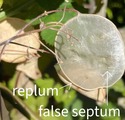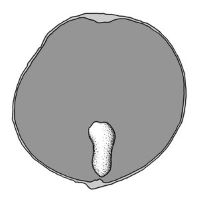Content is from Kirkbride et al. 2006Kirkbride et al. 2006:
Kirkbride JH, Jr, Gunn CR, and Dallwitz MJ. 2006. Family guide for fruits and seeds, vers. 1.0. Accessed September 2020-January 2022. URL: https://nt.ars-grin.gov/seedsfruits/keys/frsdfam/index.cfm ., without modification.
Updates are forthcoming.
Fruits: Pistil(s) compound; 1 to more than 21; 1–24-pistillate; with carpels united. Fruit pericarpium; multiplemultiple:
fruit formed from several flowers clustered in one mass
; baccetum (Spjut Fig. 12E & 6 families: Annonaceae, Austrobaileyaceae, Lardizabalaceae, Ranunculaceae, Schisandraceae, Winteraceae), or follicetum, or syncarpium (Spjut 4 families: Annonaceae, Himantandraceae, Magnoliaceae, Winteraceae); without persistent central column; not within accessory organ(s); (1-)several to many; (1-)several to many; less than 1 cm long; 0.5–0.9 cm long; with 1-carpellate (to several to many); with carpels separate (or essentially); with carpels remaining united at maturity; with carpels not radiating at maturity; without sterilesterile:
lacking male and/or female reproductive parts; also, not producing fruit or seed
 carpels; apexapex:
carpels; apexapex:
the point farthest from the point of attachment, or the "tip" of an organ beaked, or not beaked; apexapex:
beaked, or not beaked; apexapex:
the point farthest from the point of attachment, or the "tip" of an organ short beaked; wall fleshy; dehiscentdehiscent:
short beaked; wall fleshy; dehiscentdehiscent:
(v. dehisce) splitting open at maturity to release contents (of a fruit) , or indehiscentindehiscent:
, or indehiscentindehiscent:
not opening on its own, as in a fruit
 . Dehiscentdehiscent:
. Dehiscentdehiscent:
(v. dehisce) splitting open at maturity to release contents (of a fruit) unit endocarp(s). Dehiscentdehiscent:
unit endocarp(s). Dehiscentdehiscent:
(v. dehisce) splitting open at maturity to release contents (of a fruit) and shedding seeds; without replumreplum:
and shedding seeds; without replumreplum:
the rim, formed by the persistent placentas, and connected by a false septum in Brassicaceae fruits. The fruit valves are attached to this rim and separate from it in dehiscent fruits. . Epicarpepicarp:
. Epicarpepicarp:
outer layer of fruit wall or pericarp, if divided into layers; note here used synonymously with exocarp black, or purple, or red; durable; glabrousglabrous:
black, or purple, or red; durable; glabrousglabrous:
without hairs
; without armature; without wing(s); without apicalapical:
at or pertaining to the end of the seed or fruit distal from its point of attachment (i.e., base)
respiratory hole. Mesocarpmesocarp:
the middle layer of the pericarp, if divided into layers present. Endocarpendocarp:
present. Endocarpendocarp:
the inner layer of the pericarp, if divided into layers absent. Funiculusfuniculus:
absent. Funiculusfuniculus:
(alt. funicle) stalk connecting the ovule (later seed) to the ovary (later fruit) placenta short; short without seed bearing hookswith hooks:
short; short without seed bearing hookswith hooks:
bristles or spines with curved or backwards pointing tips, or with secondary bristles along their length (retinacula); not persisting in fruit after seed shed.
(retinacula); not persisting in fruit after seed shed.
Seeds: Arilaril:
(broad sense) appendicular structure that wholly or partly envelops a seed and is produced from or a modification of the funicle, raphe, or outer integument; usually fleshy or pulpy, sometimes spongy or tufted-capillate, often brightly colored absent. Seed larger than minute; 1 to less than 5 mm long, or 5 to less than 10 mm long; 2–5 mm long; ovateovate:
absent. Seed larger than minute; 1 to less than 5 mm long, or 5 to less than 10 mm long; 2–5 mm long; ovateovate:
2D shape—egg-shaped in outline, widest point is towards one end of the organ, the other end tapers gradually, attachment at or near the broad end (compare obovate, ovoid) , or angularangular:
, or angularangular:
2D shape—having sides that meet at acute or obtuse angles
, or reniformreniform:
2D or 3D shape—kidney-shaped , or straight; not bowl shaped; not nutlike; without winglike beakbeak:
, or straight; not bowl shaped; not nutlike; without winglike beakbeak:
a usually firm, terminal appendage, sometimes tapered ; without caudatecaudate:
; without caudatecaudate:
tapering to a long, tail-like appendage appendage(s); at maturity with food reserves; with endosperm; without canavanine. Sarcotestasarcotesta:
appendage(s); at maturity with food reserves; with endosperm; without canavanine. Sarcotestasarcotesta:
pulpy or fleshy outer layer of the seed coat, simulates aril absent. Testatesta:
absent. Testatesta:
seed coat
 present; without markedly different marginalmarginal:
present; without markedly different marginalmarginal:
at, on, or close to the margin or border
tissue; without fleshy or leatheryleathery:
texture—moderately thick, tough, and very pliable
layer over hard layer; tight; surface unsmooth; without crease or line separating cotyledons from hypocotyl-radicle; with notch along margin where cotyledons from hypocotyl-radicle tip approaching each other, or without notch along margin where cotyledons from hypocotyl-radicle tip approach each other; without glands; without bristles; glabrousglabrous:
without hairs
; without wings; without collar; without operculumoperculum:
a dehiscent cap (or lid) of a seed or fruit that opens during germination or dehiscence ; colored; monochrome; black, or brown (all shades); hard; not becoming mucilaginousmucilaginous:
; colored; monochrome; black, or brown (all shades); hard; not becoming mucilaginousmucilaginous:
resembling mucilage; moist and sticky
when wetted; surrounding food reserve. Endosperm copious; smooth; with oils; without fatty acid containing cyclopropene; without apicalapical:
at or pertaining to the end of the seed or fruit distal from its point of attachment (i.e., base)
lobes; without chlorophyll; without isodiametric faceted surface; without odor. Embryo differentiated from food reserve; rudimentaryrudimentary:
(of embryo) embryo is small and fills less than a quarter of the seed and can be variable in shapes, such as linear, spatulate, or oval ; 1 per seed; partially filling testatesta:
; 1 per seed; partially filling testatesta:
seed coat
 (with food reserve); 0.04 times the length of food reserve; at one end of seed not extending into a depression or cup; miniature; dwarf; straight; parallel to seed length; embedded in endosperm; without coleorhiza; without simmondsin; without stomata; not green; acotyledonous, or with 2 or more cotyledons (barely). Cotyledons 2; as wide as hypocotyl-radicle; 1 times wider than hypocotyl-radicle; not concealing hypocotyl-radicle; not foliaceous; smooth; with apicesapex:
(with food reserve); 0.04 times the length of food reserve; at one end of seed not extending into a depression or cup; miniature; dwarf; straight; parallel to seed length; embedded in endosperm; without coleorhiza; without simmondsin; without stomata; not green; acotyledonous, or with 2 or more cotyledons (barely). Cotyledons 2; as wide as hypocotyl-radicle; 1 times wider than hypocotyl-radicle; not concealing hypocotyl-radicle; not foliaceous; smooth; with apicesapex:
the point farthest from the point of attachment, or the "tip" of an organ entire; with margins separate; basally entire; equal in size; not punctatepunctate:
entire; with margins separate; basally entire; equal in size; not punctatepunctate:
surface relief - dotted with pits or with translucent, sunken glands or with colored dots, similar to pitted dotted. Hypocotyl-radicle vestigial; straight; not thickened.
dotted. Hypocotyl-radicle vestigial; straight; not thickened.
Literature specific to this family: Sampson, F.B., J.B. Williams, & P.S. Woodland. 1988. The morphology and taxonomic position of Tasmannia glaucifolia (Winteraceae), a new Australian species. Austral. J. Bot. 36:395–413.
General references: Corner, E.J.H. 1976. The seeds of Dicots, esp. vol. 2. Cambridge University Press, New York, Cronquist, A. 1981. An integrated system of classification of flowering plants, 1,262 p. Columbia University Press, New York, Goldberg, A. 1986 (dicots) & 1989 (monocots). Classification, evolution, and phylogeny of the familes of Dicotyledons. Smithsonian Contr. Bot. 58 for dicots (314 pp.) & 71 for monocots (74 pp.). [Goldberg's illustrations are reproduced from older publications and these should be consulted], Gunn, C.R., J.H. Wiersema, C.A. Ritchie, & J.H. Kirkbride, Jr. 1992 & amendments. Families and genera of Spermatophytes recognized by the Agricultural Research Service. Techn. Bull. U.S.D.A. 1796:1–500, Mabberley, D.J. 1987. The plant-book, 706 p. Cambridge University Press, Cambridge, Morley, B.D. & H.R. Toelken, eds. 1983. Flowering Plants in Australia, 416 pp. Rigby, Adelaide, and Spjut, R.W. 1994. A systematic treatment of fruit types. Mem. New York Bot. Gard. 70:1–182.